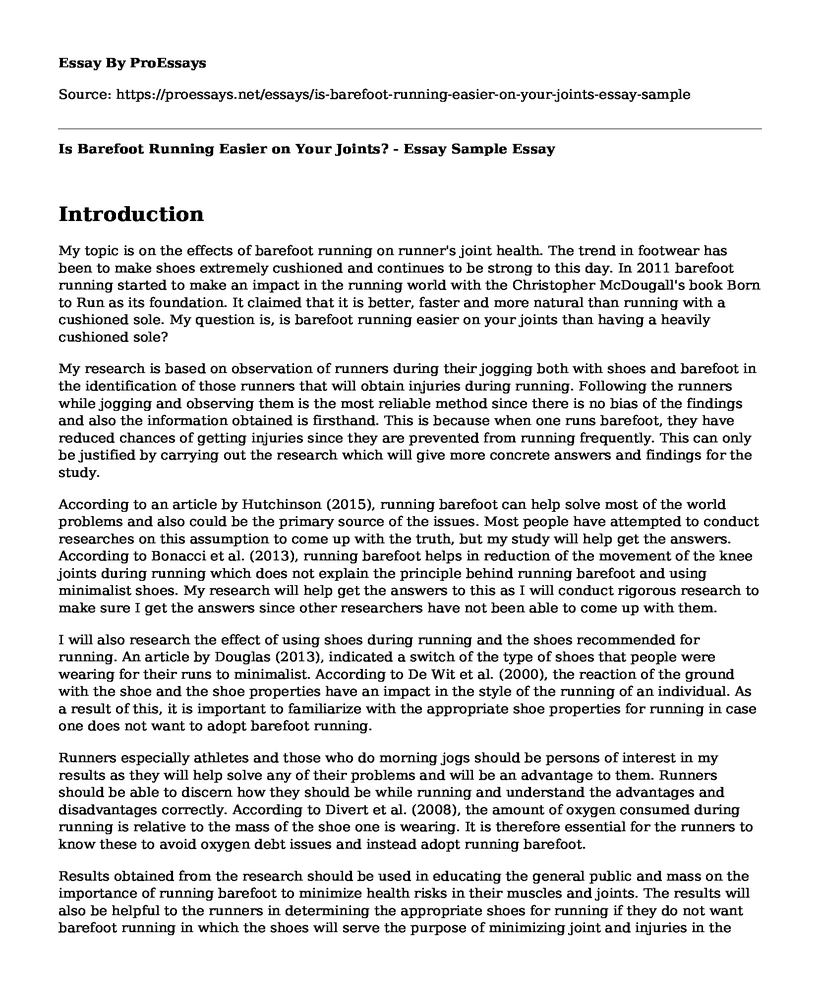Introduction
My topic is on the effects of barefoot running on runner's joint health. The trend in footwear has been to make shoes extremely cushioned and continues to be strong to this day. In 2011 barefoot running started to make an impact in the running world with the Christopher McDougall's book Born to Run as its foundation. It claimed that it is better, faster and more natural than running with a cushioned sole. My question is, is barefoot running easier on your joints than having a heavily cushioned sole?
My research is based on observation of runners during their jogging both with shoes and barefoot in the identification of those runners that will obtain injuries during running. Following the runners while jogging and observing them is the most reliable method since there is no bias of the findings and also the information obtained is firsthand. This is because when one runs barefoot, they have reduced chances of getting injuries since they are prevented from running frequently. This can only be justified by carrying out the research which will give more concrete answers and findings for the study.
According to an article by Hutchinson (2015), running barefoot can help solve most of the world problems and also could be the primary source of the issues. Most people have attempted to conduct researches on this assumption to come up with the truth, but my study will help get the answers. According to Bonacci et al. (2013), running barefoot helps in reduction of the movement of the knee joints during running which does not explain the principle behind running barefoot and using minimalist shoes. My research will help get the answers to this as I will conduct rigorous research to make sure I get the answers since other researchers have not been able to come up with them.
I will also research the effect of using shoes during running and the shoes recommended for running. An article by Douglas (2013), indicated a switch of the type of shoes that people were wearing for their runs to minimalist. According to De Wit et al. (2000), the reaction of the ground with the shoe and the shoe properties have an impact in the style of the running of an individual. As a result of this, it is important to familiarize with the appropriate shoe properties for running in case one does not want to adopt barefoot running.
Runners especially athletes and those who do morning jogs should be persons of interest in my results as they will help solve any of their problems and will be an advantage to them. Runners should be able to discern how they should be while running and understand the advantages and disadvantages correctly. According to Divert et al. (2008), the amount of oxygen consumed during running is relative to the mass of the shoe one is wearing. It is therefore essential for the runners to know these to avoid oxygen debt issues and instead adopt running barefoot.
Results obtained from the research should be used in educating the general public and mass on the importance of running barefoot to minimize health risks in their muscles and joints. The results will also be helpful to the runners in determining the appropriate shoes for running if they do not want barefoot running in which the shoes will serve the purpose of minimizing joint and injuries in the knees and ankles. The information obtained can be disseminated through publishing in health journals, newspapers, blogs or social media. Advertisement in the televisions and radios on the importance and benefits of incorporating barefoot running instead of shod running.
References
Bonacci, J., Saunders, P.U., Hicks, A., Rantalainen, T., Vicenzino, B.G.T., 7 Spratford, W. (2013). Running in a minimalist and lightweight shoe is not the same as running barefoot: a biomechanical study. Br J Sports Med, 47(6), 387-392.
De Wit, B., De Clercq, D., & Aerts, P. (2000). Biomechanical analysis of the stance phase during barefoot and shod running. Journal of Biomechanics, 33(3), 269-278.
Divert, C., Mornieux, G., Freychat, P., Baly, L., Mayer, F., & Belli, A. (2008). Barefoot-shod running differences: shoe or mass effect? International journal of sports medicine, 29(06). 512-518.
Alex, H. (2015). Running injuries in shoes and barefoot. Retrieved from https://www.runnersworld.com/health-injuries/a20848857/running-injuries-in-shoes-and-barefoot/Douglas, S. (2013). Minimalism in the long run. Retrieved from https://www.runnersworld.com/advanced/a20804121/minimalism-in-the-long-run/
Cite this page
Is Barefoot Running Easier on Your Joints? - Essay Sample. (2022, Dec 22). Retrieved from https://proessays.net/essays/is-barefoot-running-easier-on-your-joints-essay-sample
If you are the original author of this essay and no longer wish to have it published on the ProEssays website, please click below to request its removal:
- Course Work Example: Evidence-Based Research in Nursing
- Paper Example on Person-Centered Care
- Essay Sample on Cannabis in Healthcare
- Universal Health in America Essay Example
- Creating a DNP Project: A Guide for Nursing Professionals - Essay Sample
- Paper Example on Female Muslim Patient Refusal: Understanding Cultural Diversity in Hospital Care
- Essay Sample on Care and Compassion in Nursing







